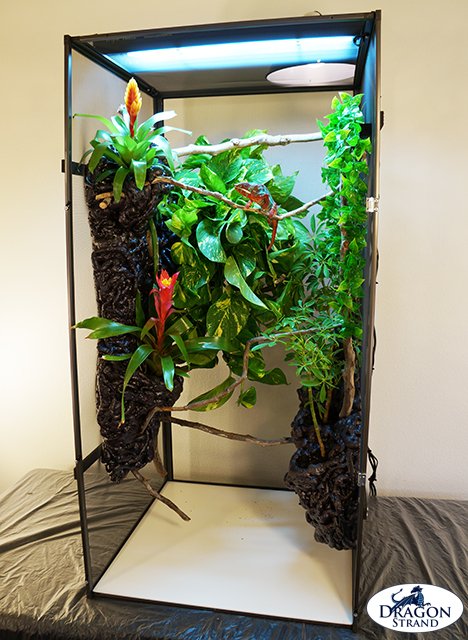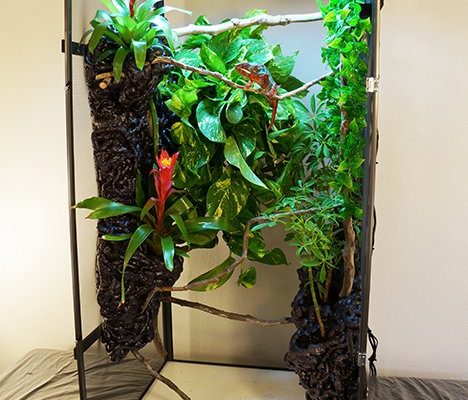
Choosing the Right Enclosure Size
The first thing you need to consider is size. Oustalet’s chameleons are one of the larger species, so they need plenty of room to move around. A good rule of thumb is to aim for an enclosure that’s at least 4 feet tall and 2 feet wide. Imagine giving your chameleon a three-story house; it will appreciate the vertical space for climbing!
If you can afford it, a larger enclosure is always better. A 6-foot tall setup can provide an even more enriching environment. The height allows you to create different temperature zones, giving your chameleon options for basking or cooling down as needed. Don’t forget: the wider the space, the more branches and plants you can add, creating a miniature jungle for your chameleon!
Here’s a quick list of recommended sizes:
- Minimum: 4 feet tall x 2 feet wide
- Ideal: 6 feet tall x 3 feet wide
Choosing the Right Materials
Now that you’ve got the size figured out, let’s talk about what materials to use for the enclosure. You have a couple of options: glass, mesh, or combination enclosures. Glass is great for visibility but can create poor ventilation. Mesh is excellent for airflow and humidity control, which is crucial for your chameleon’s health.
Honestly, a combination setup often works best. The lower part can be glass for easy viewing, while the upper part features mesh for proper ventilation. This way, you get the best of both worlds—your chameleon gets fresh air and a lovely view, and you get a clear look at your beautiful pet.
When building or buying your enclosure, consider:
- Ventilation: Ensure there are enough openings for airflow.
- Durability: Choose materials that can withstand humidity and temperature changes.
- Easy Access: Large doors make it easier to clean and feed your chameleon without stress.
Creating a Natural Habitat
Next up: making the enclosure feel like home. Your Oustalet’s chameleon thrives in an environment that mimics its natural habitat. This means adding live plants, branches, and hiding spots. Think of your enclosure as a delightful maze for your chameleon!
Plants like pothos, ficus, and hibiscus are not just pretty; they provide climbing surfaces and hiding spots. When arranging these plants, keep in mind the height and climbing preferences of your chameleon. You can also create different levels using branches. Just make sure they’re sturdy enough to hold your chameleon’s weight.
Here are a few tips:
- Use a variety of plant heights: This creates a more interesting landscape.
- Secure branches well: You want to ensure they don’t wobble when your chameleon climbs on them.
- Consider the lighting: Place your basking spot near the top where it can get the most light.
Temperature and Lighting Control
Keeping the right temperature is crucial for your chameleon. They need a basking spot around 85-95°F (29-35°C) during the day. For the cooler areas, aim for around 75-80°F (24-27°C). A temperature gradient allows your chameleon to choose where it feels comfortable, which is key to its well-being.
To achieve this, you can use a combination of heat lamps and UVB lights. UVB lighting is super important because it helps your chameleon synthesize vitamin D3, crucial for calcium absorption. Think of it like giving them a dose of sunshine, even when it’s cloudy outside!
Here’s a quick setup:
- Basking Light: A bright heat lamp placed on one side of the enclosure.
- UVB Light: A separate bulb that covers most of the enclosure to ensure your chameleon gets enough UV exposure.
- Thermometers: Place one at the basking spot and another in the cooler area to keep track of temperatures.
Humidity and Watering Needs
Humidity is another essential factor. Oustalet’s chameleons thrive in humidity levels around 50-70%. This might sound tricky, but it’s pretty manageable with some planning. You can mist the enclosure daily or invest in a humidity gauge to monitor levels accurately.
Consider using a drip system or a small water bowl. However, most chameleons prefer to drink water droplets from leaves. To achieve this, misting is the way to go. Just think of it as giving your chameleon its daily spa treatment!
Just a few pointers:
- Regular Misting: Misting in the morning and evening keeps humidity levels stable.
- Drip System: This can provide a gentle flow of water, simulating natural rain.
- Humidity Gauge: Keep one in the enclosure to monitor levels easily.
Cleaning and Maintenance Tips
Finally, let’s talk about keeping everything clean. A clean environment is key to your chameleon’s health. Spot-clean daily by removing leftover food and waste. Once a week, you might want to do a deeper clean, wiping down surfaces and checking that plants and decor are healthy.
For any surfaces, use non-toxic cleaners. You wouldn’t want your chameleon to get sick from something as simple as a cleaning product, right?
Here’s a maintenance routine you can follow:
- Daily: Remove uneaten food and waste.
- Weekly: Clean plants and decor, and change substrate if needed.
- Monthly: Deep clean the enclosure, thoroughly wash everything with a safe cleaner.
In conclusion, setting up the best enclosure for your Oustalet’s chameleon is all about creating a comfortable, natural environment. By focusing on size, materials, natural elements, temperature, humidity, and thorough cleaning, you’re on your way to ensuring your chameleon lives a happy and healthy life. Remember, every little detail counts, and your chameleon will appreciate the effort!

